1. Introduction
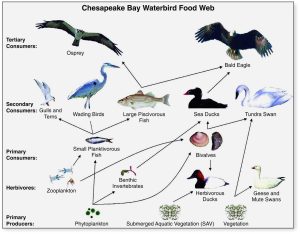
In the previous tutorial, we examined food chains and food webs. Now that we know about the different roles that organisms can play in ecosystems, we can explore how the flow of energy shapes an ecosystem. What does that mean? As we’ll see, energy flow and energy availability determine how many producers, primary consumers, and secondary consumers are in an ecosystem.
Let’s start with a thought experiment.
2. A thought experiment. In a giant spaceship — an artificial ecosystem with a fixed amount of energy — could you support more carnivores or herbivores?
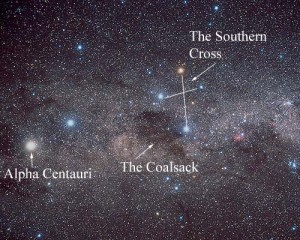
In the distant future, humans might try to colonize the Earth-like planets that are being discovered in orbit around other stars. Pretend that you’re the director of the first spaceship to colonize the nearest solar system, Alpha Centauri. It’s 4.6 lightyears away. That means that light, traveling at 300,000 kilometers/second, takes 4.6 years to get from where we are to that star.
Even with revolutionary improvements in engineering, it’s going to take a long time to get there. If our ship moved at 1/10th light speed (about 100,000,000 kilometers/hour) it would take 46 years.
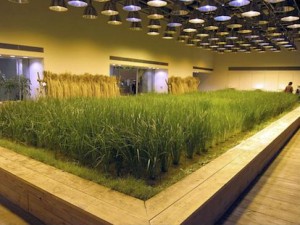
One consequence of having to embark on such a long journey is that the colonists are not going to be able to bring enough food to supply them for the whole trip: storing 46 years’ worth of food would make the ship impossibly big and heavy. Instead, they’re going to have to grow their food on the ship, and recycle every bit of it.
To make the population of our new world as healthy and adaptable as possible, we’re going to want our crew to be as diverse and big as possible. After all, we’re going to found a new world. If you remember back to AP Bio Topics 7.4-7.5 (Population Genetics), we’ll want to avoid the loss of genetic variability associated with the founder effect.
So here’s the question: to maximize crew size, should the crew eat mostly as herbivores, with most of their food coming from plants? Or should they eat mostly as carnivores, getting most of their food from animals that eat plants? You can think of the second option as something like the typical North American diet (one that you might be following right now), where some form of meat can be the main source of calories at every meal.
Remember that this is a thought experiment: you might be able to think of an “in-between” solution, but please don’t. Think of the consequences of one strategy (vegetarianism) versus the other (being almost exclusively carnivorous).
In the carnivore strategy, our crew people would grow plants that they would feed to animals such as fish, chicken, and cows, and then eat the meat from these animals. Space and available energy on the ship are limited. What strategy will enable us to have the largest possible crew?
Here are a couple of facts to keep in mind as you think about your decision. Assume that in either strategy, your crew will be able to get an adequate supply of protein, vitamins, and minerals.
- The ship is powered by a nuclear reactor that can provide enough light to grow a lot of food.
- Using this energy, we can harvest 2,000,000 calories of plant food energy every day.
- A calorie is a unit of food energy. Here are some typical foods and their caloric value.
- An apple: about 100 Calories.
- A slice of bread: about 100 calories
- A quarter of a pound of ground beef: about 200 calories.
- A cup of brown rice: about 200 calories
- A cup of broccoli: about 30 calories
- A tablespoon of vegetable oil: 120 calories
- To keep their body weight constant, a person who weighs 150 pounds needs to consume about 2250 calories/day.
So, make your decision. Please write down your thoughts in your student learning guide. Use the following sentence frame:
To support the largest possible crew, we should eat as … My reasoning is …
Don’t continue until you’ve written down your thoughts.
3. The Easy Math of Energy Transfer in Trophic Levels
The answer lies in the principles of ecology.
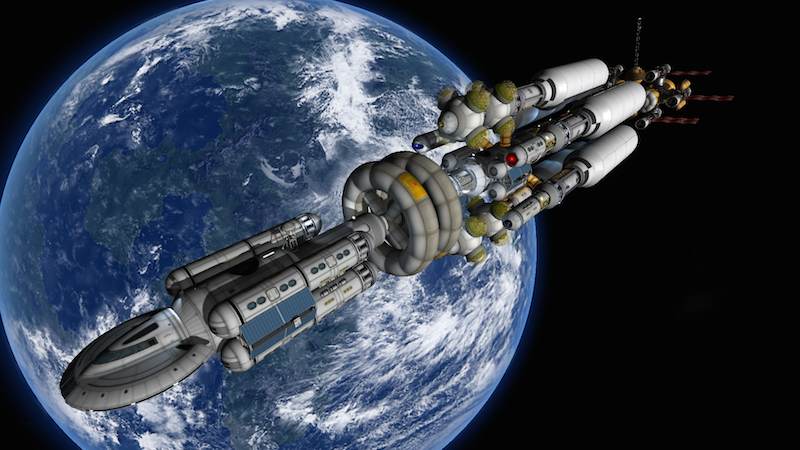
To keep the math easy, let’s set 2000 Calories/day as our average target calorie intake for each crewperson.
Remember that our ship can produce a lot of energy: enough to grow 2,000,000 food calories worth of food each day. What we’re growing, of course, are plants. If we stick to a strict vegetarian diet, then the math is straightforward: 2,000,000 calories of plant food/day, divided by 2000 calories/day/crewperson= 1000 crew people.
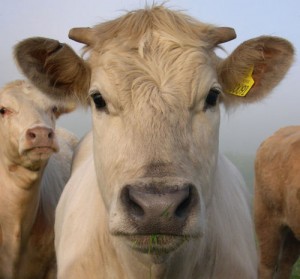
But what happens if we wanted to eat as carnivores? We would take the seeds, grain, leaves, and other plant food that we produced on our ship’s farms, and we would feed it to cows (or other animals, such as chickens). Then, instead of eating plant foods like bread and apples, we’d eat steak. If we measured the amount of chemical energy available to us from the cows, how much energy would be available for the crew?
Make a prediction:
[qwiz style = “border: 3px solid black; ” qrecord_id=”sciencemusicvideosMeister1961-What happens to two million calories (v2.0)”]
[h]What happens to 2,000,000 plant calories …
[q] If 2,000,000 calories are available from plants, how many calories will be available if we feed those plants to animals, and then eat the animals?
[c]MjAsMDAwLDAwMA==[Qq]
[c]MiwwMDAsMDAw[Qq]
[c]MjAs MDAw[Qq]
[f]Tm8uIFdoYXQgeW91JiM4MjE3O3JlIHN1Z2dlc3RpbmcgaXMgdGhhdCAyLDAwMCwwMDAgY2Fsb3JpZXMgaW4gcGxhbnRzIHdpbGwgYmVjb21lIDIwLDAwMCwwMDAgY2Fsb3JpZXMgaW4gYW5pbWFscy4gTm90IHBvc3NpYmxlLiBBIGtleSBwcmluY2lwbGUgaW4gcGh5c2ljcyBpcyB0aGF0IGFueSB0aW1lIHlvdSB0cmFuc2Zvcm0gZW5lcmd5IGZyb20gb25lIGZvcm0gdG8gYW5vdGhlciwgeW91IGxvc2UgZW5lcmd5LiBBIG1lYXQtYmFzZWQgZGlldCB3aWxsIHRha2UgdGhlIDIsMDAwLDAwMCBjYWxvcmllcyB5b3UgaGFkIGluIHBsYW50IGZvb2QsIGFuZCByZWR1Y2UgaXQgdG8gMjAwLDAwMCBjYWxvcmllcyBpbiBtZWF0Lg==[Qq]
[f]Tm8uIFdoYXQgeW91JiM4MjE3O3JlIHN1Z2dlc3RpbmcgaXMgdGhhdCAyLDAwMCwwMDAgY2Fsb3JpZXMgaW4gcGxhbnRzIHdpbGwgc3RheSB0aGUgc2FtZSBhZnRlciBiZWluZyBmZWQgdG8gYW5pbWFscy4gTm90IHBvc3NpYmxlLiBBIGtleSBwcmluY2lwbGUgaW4gcGh5c2ljcyBpcyB0aGF0IGFueSB0aW1lIHlvdSB0cmFuc2Zvcm0gZW5lcmd5IGZyb20gb25lIGZvcm0gdG8gYW5vdGhlciwgeW91IGxvc2UgZW5lcmd5LiBBIG1lYXQtYmFzZWQgZGlldCB3aWxsIHRha2UgdGhlIDIsMDAwLDAwMCBjYWxvcmllcyB5b3UgaGFkIGluIHBsYW50IGZvb2QsIGFuZCByZWR1Y2UgaXQgdG8gMjAwLDAwMCBjYWxvcmllcyBpbiBtZWF0Lg==[Qq]
[f]WWVzLiAyLDAwMCwwMDAgY2Fsb3JpZXMgaW4gcGxhbnRzIHlpZWxkIGFib3V0IDIwMCwwMDAgY2Fsb3JpZXMgYWZ0ZXIgYmVpbmcgZmVkIHRvIGhlcmJpdm9yZXMvcHJpbWFyeSBjb25zdW1lcnMgKGJlY2F1c2Ugb2YgdGhlIDEwJSBydWxlKS4gSWYgdGhlc2UgcHJpbWFyeSBjb25zdW1lcnMgYXJlIGZlZCB0byBjYXJuaXZvcmVzLCB0aGVuIDIwLDAwMCBjYWxvcmllcyB3b3VsZCBiZSBhdmFpbGFibGUgdG8gdGhlIHRyb3BoaWMgbGV2ZWwgdGhhdCB3YXMgZWF0aW5nIHRob3NlIGNhcm5pdm9yZXMuIEEga2V5IHByaW5jaXBsZSBpbiBwaHlzaWNzIGlzIHRoYXQgYW55IHRpbWUgeW91IHRyYW5zZm9ybSBlbmVyZ3kgZnJvbSBvbmUgZm9ybSB0byBhbm90aGVyLCB5b3UgbG9zZSBlbmVyZ3ksIGFuZCB5b3UmIzgyMTc7cmUgc2VlaW5nIHRoaXMgcHJpbmNpcGxlIGluIGFjdGlvbi4=[Qq]
[x]
[restart]
[/qwiz]
Scroll down a bit to continue.
As you’ve just seen, here are the numbers:
| 1) Harvestable food energy available in plants | 2,000,000 calories |
| 2) Harvestable food energy available in animals that eat the plants | 200,000 calories |
Harvestable energy means exactly what it says. Imagine taking all of the plants that we can grow on the ship, harvesting them, and measuring their energy. That would be the first row: harvestable energy available in plants. The second row is the energy available to us from the meat of the animals that ate the plants.
Note that the total food energy that we could harvest from the animals is only 10% of the energy in the plants that we fed to the animals. Or, using the terms related to trophic levels that we learned in the previous tutorial, the harvestable energy in the producers (plants) is ten times as great as the harvestable energy in primary consumers.
The loss of 90% of the available food energy from producers to consumers is a well-known rule in ecology. It’s the 10 Percent Rule. To make sure that you’re getting this, try to label the diagram below. Note that in this ecosystem, the energy available to the producers starts at 600,000 units of energy.
[qwiz style=”width: 700px !important; min-height: 400px !important;” qrecord_id=”sciencemusicvideosMeister1961-Trophic Levels and Harvestable Energy (v2.0)”]
[h]Interactive Diagrams: Trophic Levels and Harvestable Energy
[q labels = “top”]
[l]producers
[fx] No. Please try again.
[f*] Correct!
[l]primary consumer
[fx] No. Please try again.
[f*] Excellent!
[l]secondary consumer
[fx] No, that’s not correct. Please try again.
[f*] Correct!
[l]Third-level consumer
[fx] No, that’s not correct. Please try again.
[f*] Good!
[l]600,000
[fx] No. Please try again.
[f*] Good!
[l]60,000
[fx] No, that’s not correct. Please try again.
[f*] Excellent!
[l]6,000
[fx] No. Please try again.
[f*] Excellent!
[l]600
[fx] No, that’s not correct. Please try again.
[f*] Great!
[q multiple_choice=”true”]If an ecosystem has 500,000 units of harvestable energy available in its producers, the amount of energy available to the secondary consumers from the primary consumers will be
[c]NTAwLDAwMCB1bml0cw==[Qq]
[f]Tm8uIFJlbWVtYmVyIHRoZSAxMCUgcnVsZS4gV2hhdCYjODIxNztzIDEwJSAob25lLXRlbnRoKSBvZiA1MDAsMDAwPw==[Qq]
[c]NTAsMDAw IHVuaXRz[Qq]
[f]Q29ycmVjdC4gNTAsMDAwIGlzIDEwJSBvZiA1MDAsMDAwLg==[Qq]
[c]NTAwMCB1bml0cw==[Qq]
[f]Tm8uIFJlbWVtYmVyIHRoZSAxMCUgcnVsZS4gV2hhdCYjODIxNztzIDEwJSAob25lLXRlbnRoKSBvZiA1MDAsMDAwPw==[Qq]
[q multiple_choice=”true”]How much energy gets lost as energy gets transferred from one trophic level to the next?
[c]OTkl[Qq]
[f]Tm8uIFJlbWVtYmVyIHRoZSAxMCUgcnVsZS4gV2hhdCYjODIxNztzIDEwMCAmIzgyMTE7IDEwPw==[Qq]
[c]OSU=[Qq]
[f]Tm8uIFJlbWVtYmVyIHRoZSAxMCUgcnVsZS4gV2hhdCYjODIxNztzIDEwMCAmIzgyMTE7IDEwPw==[Qq]
[c]OT Al[Qq]
[f]RXhhY3RseS4gSWYgMTAlIGdldHMgdHJhbnNmZXJyZWQsIHRoYXQgbWVhbnMgdGhhdCA5MCUgZ2V0cyBsb3N0Lg==[Qq]
[x]
[restart]
[/qwiz]
What the 10% rule says is this: If you gathered up all of the primary producers and measured their chemical energy, and then did the same with the herbivores/primary consumers, the herbivores would have only 10% of the total chemical energy that was available in the producers. And, if you gathered up all of the secondary consumers/carnivores, and compared the energy in that trophic level to the energy in the primary consumers, you’d find that once again, you’d only transferred 10% of the energy.
Let’s apply the 10% rule to the issue of the largest possible crew size on our spaceship to Alpha Centauri.
[qwiz style=”width: 700px !important; min-height: 400px !important;” qrecord_id=”sciencemusicvideosMeister1961-Ten Percent Rule and Crew Size (v2.0)”]
[h]The 10% rule and crew size on our trip to Alpha Centauri
[q labels = “top”]
[l]producer
[fx] No. Please try again.
[f*] Good!
[l]primary consumer
[fx] No. Please try again.
[f*] Excellent!
[l]secondary consumer
[fx] No. Please try again.
[f*] Great!
[l]2,000,000
[fx] No. Please try again.
[f*] Great!
[l]200,000
[fx] No. Please try again.
[f*] Great!
[l]CARNIVORE CREW
[fx] No, that’s not correct. Please try again.
[f*] Correct!
[l]HERBIVORE CREW
[fx] No, that’s not correct. Please try again.
[f*] Good!
[q]To translate what was on the previous card into actual crew-size numbers, let’s do some math.
- Eating as primary consumers/vegetarians, you’d have 2,000,000 calories available for the crew. At an average of 2,000 calories/crewmember, that would get you a crew of [hangman].
- Eating as secondary consumers/carnivores, you’d have 200,000 calories available for the crew. At an average of 2,000 calories/crewmember, your crew size drops to [hangman].
[c]MTAwMA==[Qq]
[c]MTAw[Qq]
[q]In terms of founding a colony, [hangman] colonists is better. It maximizes genetic diversity, keeping your population more adaptable. In terms of population genetics, you avoid the [hangman] effect. The vegetarian strategy is the wiser course of action.
[c]bW9yZQ==[Qq]
[c]Zm91bmRlcg==[Qq]
[x][restart]
[/qwiz]
Of course, the actual decision would be much more nuanced. In terms of food consumption, you’d have to consider the fact that humans are omnivores. It’s probably wise for the crew to have access to some animal protein. And the energy equation becomes very different if you’re considering animal products (eggs from chicken, dairy from cows) as opposed to meat. But given the limits of the size of the ship and the amount of energy it can produce, it makes sense to have the crew eat primarily as herbivores, instead of primarily as carnivores.
4. The Math of Trophic Levels: Flashcards
[qdeck bold_text=”false” style=”width: 600px !important; min-height: 400px !important;” qrecord_id=”sciencemusicvideosMeister1961-The Math of Trophic Levels (v2.0)”]
[h]The math of trophic levels: Flashcards
[i]
[q]Back to our interstellar voyage. Since your ship will have a fixed amount of energy, what’s the best feeding strategy for maximizing crew size? Justify your answer.
[a]If you have a fixed amount of energy, the best feeding strategy for maximizing crew size is to have the crew eat like herbivores. That’s because only 10% of the energy gets passed between one trophic level and the next. If the crew eats as herbivores, there will be ten times as much food energy, and you’ll be able to support a much larger crew.
[q]In terms of the relationship between producers and primary consumers, the 10% rule says that…
[a]In terms of the relationship between producers and primary consumers, the 10% rule says that only 10% of the chemical energy in the producers will get passed to the producers.
[q]How much available energy gets lost in the transfer of energy from one trophic level to the next?
[a]In the transfer of energy from one trophic level to the next, 90% of the available energy gets lost.
[x][restart]
[/qdeck]
5. Understanding the 10% Rule
 Why is so little energy transferred from one trophic level to the next?
Why is so little energy transferred from one trophic level to the next?
5a. Some energy is lost as heat
One reason has to do with the laws of physics. Whenever energy is transformed from one form to another, some of the energy gets lost as heat.
If that feels abstract, just think about what happens in a car. A car transforms the energy in gasoline into the energy of motion. But during that energy transfer, a lot of the energy in the gasoline is lost as heat. You can feel that heat coming off a car’s hood. That heat is wasted energy that isn’t moving your car. Instead, that lost heat energy dissipates (disperses, diffuses) into the environment.
In living things, the most common fuel for cellular respiration is glucose. At this point in your AP Biology journey, you should know the equation well (unless you’re starting with Unit 8).
glucose + oxygen → carbon dioxide + water + energy (ATP)
As energy in glucose is transformed into the energy of ATP, about 60% of the energy is lost as heat.
There’s more energy lost as cells convert ATP into ADP and phosphate to power cellular work.
![]()
Similarly, many of the food calories that you would feed to a cow, as they are used by the cow to keep itself alive, dissipate as heat into the environment. Add to that the fact that a cow is a mammal with a body temperature similar to yours, and you get an even greater loss of energy to heat. All of the chemical energy lost as heat is not going to be available to the next trophic level.
In my Food Chain Song (the music video is embedded below), I refer to heat loss as “metabolic rent.” As you learned in the first tutorial in AP Bio Topic 8.2, metabolism is the term used for all of the chemical reactions that happen inside living things. A cell is a complex chemical system, and all of those chemical reactions occurring within cells make up a large portion of the energy that’s lost in the transfer between trophic levels.
5b. Some food energy isn’t absorbed
Here’s a second reason why energy transfer between trophic levels is so inefficient. The diagram below, which shows a caterpillar harvesting energy from a leaf, shows heat loss, and one additional source of energy loss. Note that this diagram uses Joules (J) instead of Calories. The proportions would be the same.

The 67 J arrow on the right side (cellular respiration) is the heat loss that we’ve described above: it’s the energy that the caterpillar is using just to keep itself alive. But note the brown 100J arrow to the left labeled “feces.” Not everything that an organism ingests goes into making more of that organism. Some ingested food is indigestible and passes right through. On an ecological level, all of that defecated matter doesn’t become available to the next trophic level.
So, in the diagram above, what’s left to be transferred to the next trophic level? Only the 33J that’s labeled as “growth.”
The fact that 33/200 is 16.5%, as opposed to 10%, might seem confusing. But remember that this is an analysis of one animal eating a part of a plant. If you widen the analysis to thinking about the actual organisms living in an ecosystem, you can find additional reasons for energy loss between trophic levels. We’ll do that in a moment, but first, answer the questions below.
[qwiz qrecord_id=”sciencemusicvideosMeister1961-Ten Percent Rule in Action (v2.0)”]
[h]Quiz: The 10% rule in action
[q] In the diagram below, what is the amount of energy that passes through the caterpillar, but can’t be absorbed into the caterpillar?
[c]MTAw Sg==[Qq]
[c]MzNK[Qq]
[c]NjdK[Qq]
[c]MjAwSg==[Qq]
[f]WWVzLiAxMDAgSiBpcyBsYWJlbGVkIGFzICYjODIyMDtmZWNlcy4mIzgyMjE7IFRoYXQmIzgyMTc7cyBmb29kIGVuZXJneSB0aGF0IHBhc3NlcyB0aHJvdWdoIGFuIGFuaW1hbCBidXQgY2FuJiM4MjE3O3QgYmUgYWJzb3JiZWQu[Qq]
[f]Tm8uIDMzSiBpcyBsYWJlbGVkIGFzICYjODIyMDtncm93dGguJiM4MjIxOyBUaGF0IG1lYW5zIHRoYXQgdGhpcyBlbmVyZ3kgZ2V0cyBpbmNvcnBvcmF0ZWQgaW50byBidWlsZGluZyBtb3JlIG9mIHRoZSBjYXRlcnBpbGxhci4=[Qq]
[f]Tm8uIDY3SiBpcyBsYWJlbGVkIGFzICYjODIyMDtjZWxsdWxhciByZXNwaXJhdGlvbi4mIzgyMjE7IFRoYXQgbWVhbnMgdGhhdCB0aGlzIGVuZXJneSBpcyB1c2VkIHRvIGtlZXAgdGhlIGNhdGVycGlsbGFyIGFsaXZlLCBvciBpcyBsb3N0IGFzIGhlYXQgdG8gdGhlIGVudmlyb25tZW50Lg==[Qq]
[f]Tm8uIDIwMEogaXMgdGhlIG9yaWdpbmFsIGFtb3VudCBvZiBmb29kIGVuZXJneSBpbiB0aGUgbGVhZiB0aGF0IHdhcyBjb25zdW1lZCBieSB0aGUgY2F0ZXJwaWxsYXIu[Qq]
[q] In the diagram below, what is the amount of food energy that the caterpillar consumes?
[c]MTAwSg==[Qq]
[c]MzNK[Qq]
[c]NjdK[Qq]
[c]MjAw Sg==[Qq]
[f]Tm8uIDEwMCBKIGlzIGxhYmVsZWQgYXMgJiM4MjIwO2ZlY2VzLiYjODIyMTsgVGhhdCYjODIxNztzIGZvb2QgZW5lcmd5IHRoYXQgcGFzc2VzIHRocm91Z2ggdXMsIGJ1dCB3aGljaCB3ZSBjYW4mIzgyMTc7dCBhYnNvcmIu[Qq]
[f]Tm8uIDMzSiBpcyBsYWJlbGVkIGFzICYjODIyMDtncm93dGguJiM4MjIxOyBUaGF0IG1lYW5zIHRoYXQgdGhpcyBlbmVyZ3kgZ2V0cyBpbmNvcnBvcmF0ZWQgaW50byBidWlsZGluZyBtb3JlIG9mIHRoZSBjYXRlcnBpbGxhci4=[Qq]
[f]Tm8uIDY3SiBpcyBsYWJlbGVkIGFzICYjODIyMDtjZWxsdWxhciByZXNwaXJhdGlvbi4mIzgyMjE7IFRoYXQgbWVhbnMgdGhhdCB0aGlzIGVuZXJneSBpcyB1c2VkIHRvIGtlZXAgdGhlIGNhdGVycGlsbGFyIGFsaXZlLCBvciBpcyBsb3N0IGFzIGhlYXQgdG8gdGhlIGVudmlyb25tZW50Lg==[Qq]
[f]WWVzLiAyMDBKIGlzIHRoZSBvcmlnaW5hbCBhbW91bnQgb2YgZm9vZCBlbmVyZ3kgaW4gdGhlIGxlYWYgdGhhdCB3YXMgY29uc3VtZWQgYnkgdGhlIGNhdGVycGlsbGFyLg==[Qq]
[q] In the diagram below, what is the amount of energy that the caterpillar consumes, and which becomes more of the caterpillar?
[c]MTAwSg==[Qq]
[c]Mz NK[Qq]
[c]NjdK[Qq]
[c]MjAwSg==[Qq]
[f]Tm8uIDEwMCBKIGlzIGxhYmVsZWQgYXMgJiM4MjIwO2ZlY2VzLiYjODIyMTsgVGhhdCYjODIxNztzIGZvb2QgZW5lcmd5IHRoYXQgcGFzc2VzIHRocm91Z2ggdGhlIGNhdGVycGlsbGFyIGJ1dCBjYW4mIzgyMTc7dCBiZSBhYnNvcmJlZC4=[Qq]
[f]WWVzLiAzM0ogaXMgbGFiZWxlZCBhcyAmIzgyMjA7Z3Jvd3RoLiYjODIyMTsgVGhhdCBtZWFucyB0aGF0IHRoaXMgZW5lcmd5IGdldHMgaW5jb3Jwb3JhdGVkIGludG8gYnVpbGRpbmcgbW9yZSBvZiB0aGUgY2F0ZXJwaWxsYXIu[Qq]
[f]Tm8uIDY3SiBpcyBsYWJlbGVkIGFzICYjODIyMDtjZWxsdWxhciByZXNwaXJhdGlvbi4mIzgyMjE7IFRoYXQgbWVhbnMgdGhhdCB0aGlzIGVuZXJneSBpcyB1c2VkIHRvIGtlZXAgdGhlIGNhdGVycGlsbGFyIGFsaXZlLCBvciBpcyBsb3N0IGFzIGhlYXQgdG8gdGhlIGVudmlyb25tZW50Lg==[Qq]
[f]Tm8uIDIwMEogaXMgdGhlIG9yaWdpbmFsIGFtb3VudCBvZiBmb29kIGVuZXJneSBpbiB0aGUgbGVhZiB0aGF0IHdhcyBjb25zdW1lZCBieSB0aGUgY2F0ZXJwaWxsYXIu[Qq]
[q] In the diagram below, what is the amount of energy that the caterpillar consumes, but which gets spent supporting the caterpillar’s own life processes, or is lost as heat?
[c]MTAwSg==[Qq]
[c]MzNK[Qq]
[c]Nj dK[Qq]
[c]MjAwSg==[Qq]
[f]Tm8uIDEwMCBKIGlzIGxhYmVsZWQgYXMgJiM4MjIwO2ZlY2VzLiYjODIyMTsgVGhhdCYjODIxNztzIGZvb2QgZW5lcmd5IHRoYXQgcGFzc2VzIHRocm91Z2ggdGhlIGNhdGVycGlsbGFyIGJ1dCBjYW4mIzgyMTc7dCBiZSBhYnNvcmJlZC4=[Qq]
[f]Tm8uIDMzSiBpcyBsYWJlbGVkIGFzICYjODIyMDtncm93dGguJiM4MjIxOyBUaGF0IG1lYW5zIHRoYXQgdGhpcyBlbmVyZ3kgZ2V0cyBpbmNvcnBvcmF0ZWQgaW50byBidWlsZGluZyBtb3JlIG9mIHRoZSBjYXRlcnBpbGxhci4=[Qq]
[f]WWVzLiA2N0ogaXMgbGFiZWxlZCBhcyAmIzgyMjA7Y2VsbHVsYXIgcmVzcGlyYXRpb24uJiM4MjIxOyBUaGF0IG1lYW5zIHRoYXQgdGhpcyBlbmVyZ3kgaXMgdXNlZCB0byBrZWVwIHRoZSBjYXRlcnBpbGxhciBhbGl2ZSwgb3IgaXMgbG9zdCBhcyBoZWF0IHRvIHRoZSBlbnZpcm9ubWVudC4=[Qq]
[f]Tm8uIDIwMEogaXMgdGhlIG9yaWdpbmFsIGFtb3VudCBvZiBmb29kIGVuZXJneSBpbiB0aGUgbGVhZiB0aGF0IHdhcyBjb25zdW1lZCBieSB0aGUgY2F0ZXJwaWxsYXIu[Qq]
[x]
[restart]
[/qwiz]
5c. The organisms in higher trophic levels only harvest some of the energy below
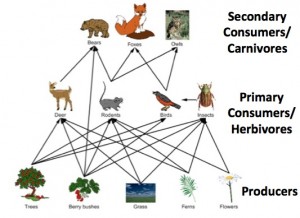
We’ve seen above that some of the energy that’s transferred between trophic levels is lost as heat. Additional energy is lost because not everything that an animal ingests gets absorbed into its body.
Here’s a third reason behind the 10% rule. The primary consumers are not going to be able to eat every last piece of the plants below them.

Just think of yourself as a primary consumer. If you eat any product made from wheat (bread, cereal, cake) you’re eating only a tiny portion of that plant. All you consume is the kernel: not the stem, roots, or any other part. Or consider eating an apple: there’s the whole rest of the tree that you’re not consuming.
Similarly, when you eat as a carnivore, you eat only a tiny portion of the animal that was killed to feed you. When you eat chicken, you mostly eat the muscle tissue around the breasts, back, and legs. All the rest of the chicken (bones, innards, head, feet, etc). doesn’t get transferred to you.
Here’s how I summarize this in my Food Chain Song (which you can listen to below).
Each level in a food chain yields only ten percent
Of the former level’s energy you might ask where it went
There are bones and leaves you can’t digest that really make a dent
And don’t ignore the weighty cost of metabolic rent.
5d. Ecological Pyramids show the 10% rule
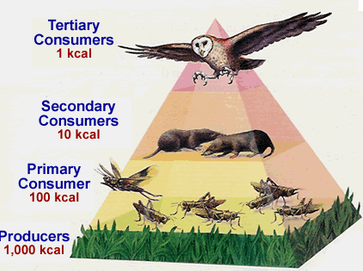
Ecologists have organized the energy loss in ecosystems into a pyramid of energy. In the pyramid, you can see available energy dropping by 90% from one trophic level to the next. Remember: 90% of the energy is lost. Only 10% is transferred.
Other ecological pyramids show other aspects of ecosystem structure. But before we look at those, let’s consolidate understanding with some flashcards.
6. Flashcards: Energy Transfer Between Trophic Levels
[qdeck bold_text=”false” style=”width: 600px !important; min-height: 400px !important;” qrecord_id=”sciencemusicvideosMeister1961-Energy Transfer Between Trophic Levels (v2.0)”]
[h]Flashcards: Energy Transfer Between Trophic Levels
[i]
[q]An image like the one below is called a
[a]An image like the one below is called a pyramid of energy.
[q]In an ecosystem, approximately _______ % of the energy is transferred from one ____________ ___________ to the one above it.
[a]In an ecosystem, approximately 10 % of the energy is transferred from one trophic level to the one above it.
[q]Explain the diagram below.
[a]The diagram below is saying that a significant amount of the food energy ingested by a consumer isn’t used for growth. A significant fraction is used during cellular respiration by the consumer to sustain its own life processes. Another significant fraction simply passes through the body of a consumer and is eliminated as feces.
[q]Explain the 10% rule. You should be able to list three reasons
[a]The 10% rule is based on
- The laws of physics. In any transfer of energy, some of the available energy is lost as heat.
- Not all of the food that an organism ingests can be absorbed. Some passes right through as feces.
- Not all of the energy available at one trophic level is harvested by the organisms at the level above it. Primary consumers don’t eat every last bit of the producers. Carnivores don’t eat every last herbivore.
[x][restart]
[/qdeck]
7. Other Ecological Pyramids
In addition to the pyramid of energy, there are two additional ecological pyramids to know about.
One is a pyramid of numbers. This pyramid shows the actual number of organisms at each trophic level. In the pyramid of numbers below, you see that 1,500,000 producers support 200,000 herbivores. These herbivores support 90,000 secondary consumers, who in turn support one top-level carnivore.
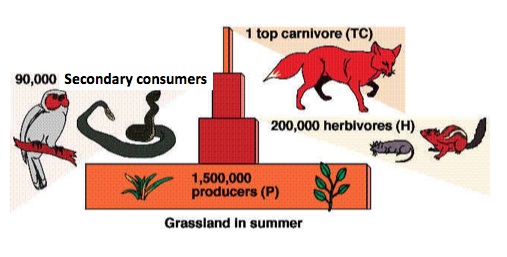
But unlike a pyramid of energy, which is always widest at its base, the pyramid of numbers can have a base that’s narrower than the levels above. Consider a forest ecosystem where one tree might support thousands of insects, which are preyed upon by birds. That pyramid would look like this:
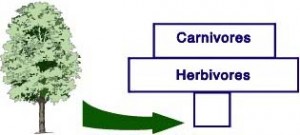
Ecosystems can also be represented through a pyramid of biomass. Biomass is living matter, and a biomass pyramid shows the amount of living matter at each trophic level. Here’s a typical biomass pyramid.
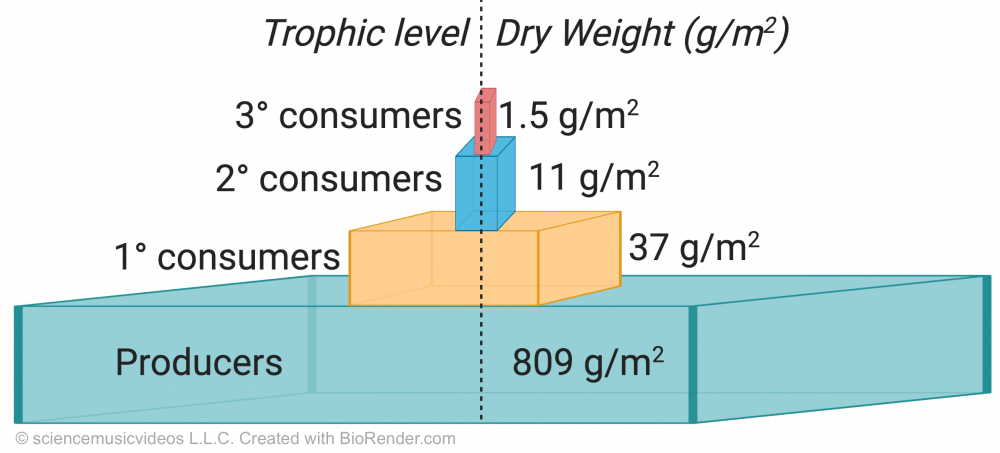
Like a pyramid of numbers, there are inverted biomass pyramids, with the base more narrow than the layers above.

That’s what’s shown in the pyramid of biomass on the far left, which shows the relationship between producers and primary consumers in the English Channel. What’s happening is that the producers, tiny organisms called phytoplankton, have a high turnover rate. They reproduce quickly, but many individuals are immediately consumed by the primary consumers (zooplankton). That minimizes the biomass of the phytoplankton to a point where it’s lower than the biomass of the zooplankton. However, because the reproduction rate of the remaining phytoplankton is so high, they can continue to support the level above.
8. Ecological Pyramids: Checking Understanding
Let’s check your understanding of ecological pyramids with this quiz.
[qwiz qrecord_id=”sciencemusicvideosMeister1961-Ecological Pyramids (v2.0)”]
[h]Quiz: Ecological Pyramids: Checking Understanding
[q] The diagram below shows a
[c]cHlyYW1pZCBvZiBlbmVyZ3k=[Qq]
[c]cHlyYW1pZCBvZiBiaW9tYXNz[Qq]
[c]cHlyYW1pZCBv ZiBudW1iZXJz[Qq]
[f]Tm8uIEEgcHlyYW1pZCBvZiBlbmVyZ3kgZGlmZmVyZW5jZXMgYXQgZWFjaCB0cm9waGljIGxldmVsLiBZb3UgY291bGQgaWRlbnRpZnkgdGhpcyBieSBlbmVyZ3ktcmVsYXRlZCB1bml0cyBzdWNoIGFzICYjODIyMDtqb3VsZXMsJiM4MjIxOyAmIzgyMjA7Y2Fsb3JpZXMsJiM4MjIxOyBldGMu[Qq]
[f]Tm8uIEJpb21hc3MgaXMgbGl2aW5nIG1hdHRlci4gQSBweXJhbWlkIG9mIGJpb21hc3Mgc2hvd3MgZGlmZmVyZW5jZXMgaW4gYmlvbWFzcyBhdCBlYWNoIHRyb3BoaWMgbGV2ZWwuIFlvdSBjb3VsZCBpZGVudGlmeSBpdCBieSB1bml0cyBzdWNoIGFzIGdyYW1zIG9yIGtpbG9ncmFtcy4=[Qq]
[f]WWVzLiBUaGlzIGlzIGEgcHlyYW1pZCBvZiBudW1iZXJzIGFuZCBzaG93cyB0aGUgbnVtYmVyIG9mIG9yZ2FuaXNtcyBhdCBlYWNoIHRyb3BoaWMgbGV2ZWwu
Cg==[Qq]
[q] The diagram below shows a
[c]cHlyYW1pZCBv ZiBlbmVyZ3k=[Qq]
[c]cHlyYW1pZCBvZiBiaW9tYXNz[Qq]
[c]cHlyYW1pZCBvZiBudW1iZXJz[Qq]
[f]WWVzLiBBIHB5cmFtaWQgb2YgZW5lcmd5IGRpZmZlcmVuY2VzIGF0IGVhY2ggdHJvcGhpYyBsZXZlbC4gWW91IGNvdWxkIGlkZW50aWZ5IHRoaXMgYnkgZW5lcmd5LXJlbGF0ZWQgdW5pdHMgc3VjaCBhcyAmIzgyMjA7am91bGVzLCYjODIyMTsgJiM4MjIwO2NhbG9yaWVzLCYjODIyMTsgZXRjLg==[Qq]
[f]Tm8uIEJpb21hc3MgaXMgbGl2aW5nIG1hdHRlci4gQSBweXJhbWlkIG9mIGJpb21hc3Mgc2hvd3MgZGlmZmVyZW5jZXMgaW4gYmlvbWFzcyBhdCBlYWNoIHRyb3BoaWMgbGV2ZWwuIFlvdSBjb3VsZCBpZGVudGlmeSBpdCBieSB1bml0cyBzdWNoIGFzIGdyYW1zIG9yIGtpbG9ncmFtcy4=[Qq]
[f]Tm8uIEEgcHlyYW1pZCBvZiBudW1iZXJzwqBzaG93cyB0aGUgbnVtYmVyIG9mIG9yZ2FuaXNtcyBhdCBlYWNoIHRyb3BoaWMgbGV2ZWwu
Cg==[Qq]
[q] The diagram below shows a
[c]cHlyYW1pZCBvZiBlbmVyZ3k=[Qq]
[c]cHlyYW1pZCBv ZiBiaW9tYXNz[Qq]
[c]cHlyYW1pZCBvZiBudW1iZXJz[Qq]
[f]Tm8uIEEgcHlyYW1pZCBvZiBlbmVyZ3kgZGlmZmVyZW5jZXMgYXQgZWFjaCB0cm9waGljIGxldmVsLiBZb3UgY291bGQgaWRlbnRpZnkgdGhpcyBieSBlbmVyZ3ktcmVsYXRlZCB1bml0cyBzdWNoIGFzICYjODIyMDtqb3VsZXMsJiM4MjIxOyAmIzgyMjA7Y2Fsb3JpZXMsJiM4MjIxOyBldGMu[Qq]
[f]WWVzLiBCaW9tYXNzIGlzIGxpdmluZyBtYXR0ZXIuIEEgcHlyYW1pZCBvZiBiaW9tYXNzIHNob3dzIGRpZmZlcmVuY2VzIGluIGJpb21hc3MgYXQgZWFjaCB0cm9waGljIGxldmVsLg==[Qq]
[f]Tm8uIEEgcHlyYW1pZCBvZiBudW1iZXJzwqBzaG93cyB0aGUgbnVtYmVyIG9mIG9yZ2FuaXNtcyBhdCBlYWNoIHRyb3BoaWMgbGV2ZWwu
Cg==[Qq]
[q] The diagram below shows a
[c]cHlyYW1pZCBvZiBlbmVyZ3k=[Qq]
[c]cHlyYW1pZCBvZiBiaW9tYXNz[Qq]
[c]cHlyYW1pZCBv ZiBudW1iZXJz[Qq]
[f]Tm8uIEEgcHlyYW1pZCBvZiBlbmVyZ3kgZGlmZmVyZW5jZXMgYXQgZWFjaCB0cm9waGljIGxldmVsLiBZb3UgY291bGQgaWRlbnRpZnkgdGhpcyBieSBlbmVyZ3ktcmVsYXRlZCB1bml0cyBzdWNoIGFzICYjODIyMDtqb3VsZXMsJiM4MjIxOyAmIzgyMjA7Y2Fsb3JpZXMsJiM4MjIxOyBldGMu[Qq]
[f]Tm8uIEJpb21hc3MgaXMgbGl2aW5nIG1hdHRlci4gQSBweXJhbWlkIG9mIGJpb21hc3Mgc2hvd3MgZGlmZmVyZW5jZXMgaW4gYmlvbWFzcyBhdCBlYWNoIHRyb3BoaWMgbGV2ZWwu[Qq]
[f]WWVzLiBBIHB5cmFtaWQgb2YgbnVtYmVyc8Kgc2hvd3MgdGhlIG51bWJlciBvZiBvcmdhbmlzbXMgYXQgZWFjaCB0cm9waGljIGxldmVsLg==
Cg==[Qq]
[q] In the diagram below, the secondary consumers are the
[c]c2hyaW1w[Qq]
[c]Ymxl YWs=[Qq]
[c]cGVyY2g=[Qq]
[f]Tm8uIFRoaXMgaXMgYSB0cmlja3kgcXVlc3Rpb24uIFRoZSBzaHJpbXAgYXJlIHNob3duIGF0IHRoZSBib3R0b20gb2YgdGhpcyBweXJhbWlkLCBidXQgeW91IGtub3cgZW5vdWdoIGFib3V0IGJpb2xvZ3kgYW5kIGVjb2xvZ3kgdG8ga25vdyB0aGF0IHNocmltcCBhcmUgYW5pbWFscywgYW5kIGNhbiYjODIxNzt0IGJlIHByb2R1Y2Vycy4gVGhlcmVmb3JlLCB0aGV5IGhhdmUgdG8gYmUgdGhlIHByaW1hcnkgY29uc3VtZXJzIGluIHRoaXMgc3lzdGVtLg==[Qq]
[f]WWVzLsKgVGhlIGJsZWFrIGFyZSBlYXRpbmcgdGhlIHNocmltcC4gU2luY2UgdGhlIHNocmltcCBoYXZlIHRvIGJlIHRoZSBwcmltYXJ5IGNvbnN1bWVycywgdGhlIGJsZWFrIGhhdmUgdG8gYmUgc2Vjb25kYXJ5IGNvbnN1bWVycy4=[Qq]
[f]Tm8uIFRoaXMgaXMgYSB0cmlja3kgcXVlc3Rpb24uIEV2ZW4gdGhvdWdoIHRoZSBwZXJjaCBhcmUgdGhlIDNyZCBsZXZlbCB1cCwgeW91IGtub3cgdGhhdCB0aGUgc2hyaW1wIGFyZSBhbmltYWxzLCBhbmQgY2FuJiM4MjE3O3QgYmUgcHJvZHVjZXJzLiBUaGVyZWZvcmUsIHRoZXkgaGF2ZSB0byBiZSB0aGUgcHJpbWFyeSBjb25zdW1lcnMgaW4gdGhpcyBzeXN0ZW0uIFRoYXQgd291bGQgbWFrZSB0aGUgcGVyY2ggYSB0aGlyZC1sZXZlbCBjb25zdW1lci4gV2hvJiM4MjE3O3MgdGhlIHNlY29uZGFyeSBjb25zdW1lcj8=[Qq]
[q] Which type of ecological pyramid HAS to be the widest at its base?
[c]UHlyYW1pZCBvZiBudW1iZXJz[Qq]
[c]UHlyYW1pZCBvZiBiaW9tYXNz[Qq]
[c]UHlyYW1pZCBv ZiBlbmVyZ3k=[Qq]
[f]Tm8uIEluIGFuIGVjb3N5c3RlbSB3aGVyZSBhIGZldyB2ZXJ5IGxhcmdlIHByb2R1Y2VycyBzdXBwb3J0IG1hbnkgY29uc3VtZXJzIChhIHRyZWUgc3VwcG9ydGluZyB0aG91c2FuZHMgb2YgaW5zZWN0cyksIHRoZSBweXJhbWlkIG9mIG51bWJlcnMgY2FuIGJlIG5hcnJvd2VyIGF0IGl0cyBiYXNlLg==
Cg==[Qq]
[f]Tm8uIFRoZXJlIGFyZSBzb21lIGFxdWF0aWMgZWNvc3lzdGVtcyB3aGVyZSwgYXQgYW55IHBvaW50IGluIHRpbWUsIHRoZXJlIGlzIG1vcmUgbWFzcyBhdCB0aGUgbGV2ZWwgb2YgcHJpbWFyeSBjb25zdW1lcnMgdGhhbiB0aGVyZSBpcyBhdCB0aGUgbGV2ZWwgb2YgcHJvZHVjZXJzLg==
Cg==[Qq]
[f]WWVzLiBBIHB5cmFtaWQgb2YgZW5lcmd5LCBiYXNlZCBvbiB0aGUgbGF3cyBvZiBwaHlzaWNzLCBoYXMgdG8gYmUgdGhlIHdpZGVzdCBhdCBpdHMgYmFzZS4gTm8gZXhjZXB0aW9ucy4=
Cg==[Qq]
[q]If the amount of chemical energy in the giraffes is 150,000 units, how much energy would be in the lions?
[c]MTUs MDAw[Qq]
[c]MTUwLDAwMA==[Qq]
[c]MSw1MDAsMDAw[Qq]
[f]WWVzLiBGb2xsb3dpbmcgdGhlIDEwJSBydWxlLCB0aGVyZSYjODIxNztkIGJlIDEwJSBvZiB0aGUgZW5lcmd5IGF2YWlsYWJsZSBpbiB0aGUgbGlvbnMgYXMgdGhlcmUgaXMgaW4gdGhlIGdpcmFmZmVzLg==[Qq]
[f]Tm8uwqBGb2xsb3dpbmcgdGhlIDEwJSBydWxlLCB0aGVyZSYjODIxNztkIGJlIDEwJSBvZiB0aGUgZW5lcmd5IGF2YWlsYWJsZSBpbiB0aGUgbGlvbnMgYXMgdGhlcmUgaXMgaW4gdGhlIGdpcmFmZmVzLg==[Qq]
[f]Tm8uwqBGb2xsb3dpbmcgdGhlIDEwJSBydWxlLCB0aGVyZSYjODIxNztkIGJlIDEwJSBvZiB0aGUgZW5lcmd5IGF2YWlsYWJsZSBpbiB0aGUgbGlvbnMgYXMgdGhlcmUgaXMgaW4gdGhlIGdpcmFmZmVzLg==[Qq]
[q]If the amount of chemical energy in the giraffes is 150,000 units, how much energy would be in the plants that support the giraffes?
[c]MTUsMDAw[Qq]
[c]MTUwLDAwMA==[Qq]
[c]MSw1MD AsMDAw[Qq]
[f]Tm8uIEZvbGxvd2luZyB0aGUgMTAlIHJ1bGUsIGhhdmUgdG8gYmUgMTAgdGltZXMgYXMgbXVjaCBlbmVyZ3kgaW4gdGhlIHRyb3BoaWMgbGV2ZWwgc3VwcG9ydGluZyB0aGUgZ2lyYWZmZXMgdGhhbiBpbiB0aGUgZ2lyYWZmZXMgdGhlbXNlbHZlcy4=[Qq]
[f]Tm8uIEZvbGxvd2luZyB0aGUgMTAlIHJ1bGUsIGhhdmUgdG8gYmUgMTAgdGltZXMgYXMgbXVjaCBlbmVyZ3kgaW4gdGhlIHRyb3BoaWMgbGV2ZWwgc3VwcG9ydGluZyB0aGUgZ2lyYWZmZXMgdGhhbiBpbiB0aGUgZ2lyYWZmZXMgdGhlbXNlbHZlcy4=[Qq]
[f]WWVzLsKgRm9sbG93aW5nIHRoZSAxMCUgcnVsZSwgaGF2ZSB0byBiZSAxMCB0aW1lcyBhcyBtdWNoIGVuZXJneSBpbiB0aGUgdHJvcGhpYyBsZXZlbCBzdXBwb3J0aW5nIHRoZSBnaXJhZmZlcyB0aGFuIGluIHRoZSBnaXJhZmZlcyB0aGVtc2VsdmVzLg==[Qq]
[x]
[restart]
[/qwiz]
9. Concluding Thoughts about Energy Flow, and the Food Chains Song
The key idea from this module is that while the matter in ecosystems is endlessly recycled, energy dissipates as it flows from one trophic level to the next. Here’s a haiku that captures this:
In ecosystems
Energy will dissipate
But matter cycles
The energy doesn’t disappear. It just becomes less useful. In almost every ecosystem on Earth, energy starts as sunlight. If the sun stopped shining, energy would stop flowing, and life would cease. Producers transform this light energy into chemical bond energy through photosynthesis, capturing it as carbohydrates. As this chemical energy moves from trophic level to trophic level, most of the energy diffuses away as heat. Consequently, fewer and fewer organisms can be supported at higher trophic levels.
The flow of energy into ecosystems is a key factor — but not the only factor — that structures the complexity of food webs. All other things being equal, ecosystems with higher energy resources can have more trophic levels. That’s why some of Earth’s most complex ecosystems — tropical rainforests and coral reefs — are located close to the equator. Along the same lines, a change in the producer level can cause a change in higher trophic levels.
I’ve tried to capture a lot of these ideas in my Food Chain song. If you are watching it in a classroom setting, please use headphones or earbuds so as not to disturb the students around you.
10. Energy flow in Ecosystems, Cumulative Flashcards
[qdeck bold_text=”false” style=”width: 600px !important; min-height: 400px !important;” qrecord_id=”sciencemusicvideosMeister1961-Energy flow in Ecosystems, Cumulative Flashcards (v2.0)”]
[h]Energy flow in Ecosystems, Cumulative Flashcards
[i]
[q json=”true” yy=”4″ unit=”8.Ecology” dataset_id=”AP_Bio_Flashcards_2022|126839a763d10″ question_number=”377″ topic=”8.2.Energy_Flow_Through_Ecosystems”] What’s the relationship between energy availability, producer population size, and ecosystem complexity? List two examples of ecosystems that demonstrate high energy input and high complexity.
[a] All other things being equal, the more energy (such as sunlight) coming into an ecosystem, the higher the productivity and population size of ecological producers, and the more trophic levels that the ecosystem will be able to support. This partly explains the diversity and complexity of tropical rainforest and coral reef ecosystems.
[q json=”true” yy=”4″ unit=”8.Ecology” dataset_id=”AP_Bio_Flashcards_2022|1248f0479c110″ question_number=”378″ topic=”8.2.Energy_Flow_Through_Ecosystems”] What are food chains and food webs?
[a] A food chain shows the passage of energy and matter from one organism to the next within an ecosystem. A food web shows all the interconnected food chains in an ecosystem.
[q json=”true” dataset_id=”AP_Bio_Flashcards_2022|274602f65205″ question_number=”379″ unit=”8.Ecology” topic=”8.2.Energy_Flow_Through_Ecosystems”] What are trophic levels?
[a] A trophic level is an organism’s position in a food chain or food web.
[q json=”true” dataset_id=”AP_Bio_Flashcards_2022|26a307b5fa05″ question_number=”380″ unit=”8.Ecology” topic=”8.2.Energy_Flow_Through_Ecosystems”] Describe the basic trophic levels found in most ecosystems.
[a]
- Producers (1) create energetic organic compounds, almost always through photosynthesis.
- Primary consumers or herbivores (2) eat producers.
- Secondary consumers or carnivores (3) eat the primary consumers.
- Secondary consumers can be consumed by tertiary consumers (4). In some oceanic food chains, there are even higher levels, but rarely more than four or five.
- When organisms at any level die their remains are broken down by decomposers (not shown)
[q json=”true” yy=”4″ unit=”8.Ecology” dataset_id=”AP_Bio_Flashcards_2022|123d4c0c28110″ question_number=”381″ topic=”8.2.Energy_Flow_Through_Ecosystems”] What do ecological pyramids represent? List the three types of ecological pyramids.
[a] Ecological pyramids are a way of showing the structure of an ecosystem, usually by trophic level. There are three types: energy, biomass, and numbers.
[q json=”true” yy=”4″ unit=”8.Ecology” dataset_id=”AP_Bio_Flashcards_2022|1232ac95e7d10″ question_number=”382″ topic=”8.2.Energy_Flow_Through_Ecosystems”] In relationship to ecology, describe a pyramid of energy and explain the 10% rule.
Importance for the AP exam: High
[a] A pyramid of energy shows the amount of harvestable chemical energy in each trophic level. In this pyramid, each trophic level has 10% of the chemical potential energy of the level beneath it. Thus, if the producers in an ecosystem had 10,000 units of energy (measured in units like kilojoules or kilocalories), the primary consumers would have 1000 units, and the secondary consumers would have 100 units.
[q json=”true” yy=”4″ unit=”8.Ecology” dataset_id=”AP_Bio_Flashcards_2022|1221a5fef4910″ question_number=”383″ topic=”8.2.Energy_Flow_Through_Ecosystems”] In relationship to ecology, describe a pyramid of biomass.
[a] A pyramid of biomass shows the biomass (living matter) available at each trophic level in an ecosystem. The 10% rule from pyramids of energy is not applicable, and in some aquatic ecosystems in which there’s high productivity and high rates of conversion of producers to primary consumers, the shape might not be pyramidal, because there might be less biomass in the producers than in the primary consumers.
[q json=”true” yy=”4″ unit=”8.Ecology” topic=”8.2.Energy_Flow_Through_Ecosystems” dataset_id=”AP_Bio_Flashcards_2022|21a26ef3df618c” question_number=”384″] In relationship to ecology, describe pyramid of numbers.
[a]
A pyramid of numbers shows the number of organisms at each trophic level. The 10% rule from the pyramid of energy is not applicable. Imagine a tree — one organism, supporting thousands of insects, supporting hundreds of birds — and you can see how the shape of this pyramid is not at all pyramidal.
[q json=”true” yy=”4″ unit=”8.Ecology” dataset_id=”AP_Bio_Flashcards_2022|1215b74204110″ question_number=”385″ topic=”8.2.Energy_Flow_Through_Ecosystems”] 1) What is a biogeochemical cycle? 2) What are the key components of biogeochemical cycles?
[a] 1) Biogeochemical cycles show the movement of elements or compounds between the biotic (living) and abiotic (non-living) parts of an ecosystem.
2) Components of biogeochemical cycles include reservoirs (locations where elements or compounds accumulate, often in chemically different forms) and fluxes or flows (ways in which these compounds or elements move from one reservoir to another one).
[q json=”true” yy=”4″ unit=”8.Ecology” dataset_id=”AP_Bio_Flashcards_2022|120c1c90f7910″ question_number=”386″ topic=”8.2.Energy_Flow_Through_Ecosystems”] Describe the carbon cycle. Note that for AP Bio, you can leave out dissolved CO2 in the oceans, absorption into rocks, and release from volcanoes.
[a]Through photosynthesis (A), producers fix carbon dioxide in air or water into carbohydrates and other compounds. Some of this carbon moves to animals via consumption (C). Both plants and animals respire (B and D), which returns CO2 to the atmosphere. When plants or animals die (E and F), their organic remains are decomposed. Decomposition (G) renders the carbon in dead organic matter back into carbon dioxide, which rejoins the atmosphere.
[q json=”true” yy=”4″ unit=”8.Ecology” dataset_id=”AP_Bio_Flashcards_2022|11e5420a8ad10″ question_number=”387″ topic=”8.2.Energy_Flow_Through_Ecosystems”] What is the 10% rule?
[a] The 10% rule is the key principle behind the pyramid of energy. Specifically, in any ecosystem, only 10% of the available energy gets passed from one trophic level to the next.
[q json=”true” dataset_id=”AP_Bio_Flashcards_2022|1556beb88c40a3″ question_number=”388″ unit=”8.Ecology” topic=”8.2.Energy_Flow_Through_Ecosystems”] Describe some of the reasons behind the 10% rule.
[a] The 10% rule results from:
- Entropy: Whenever energy is transformed from one form to another (from the bodies of herbivores to the bodies of carnivores, for example), some energy is lost as heat.
- Inefficient harvest: Consumers don’t eat everything in the trophic level below.
- Not everything that gets consumed will be absorbed into the body: everything that’s defecated out constitutes matter and energy that aren’t passed on to the organism.
- Much energy goes to staying alive, and not to growth that can be passed on to the next trophic level.
[x][restart]
[/qdeck]
11. Trophic Levels and Energy Pyramids Quiz
[qwiz qrecord_id=”sciencemusicvideosMeister1961-Trophic levels and Energy Pyramids (v2.0)”]
[h]Quiz: Trophic levels and Energy Pyramids
[i]
[q topic= “trophic_levels_and_energy”]A feeding level, such as primary consumer or secondary consumer, is also known as a(n)
[c]IHRyb3BoaW MgbGV2ZWw=[Qq]
[c]IGVjb2xvZ2ljYWwgbGV2ZWw=[Qq]
[c]IEhhYml0YXQ=[Qq]
[c]IGVjb2xvZ2ljYWwgbmljaGU=[Qq]
[f]IENvcnJlY3QuIEEgZmVlZGluZyBsZXZlbCBpcyBtb3JlIGZvcm1hbGx5IGtub3duIGFzIGEgdHJvcGhpYyBsZXZlbC4=[Qq]
[f]IE5vLiBZb3XigJlyZSBsb29raW5nIGZvciBhIHRlcm0gdGhhdCByZWxhdGVzIHRvIGFuIG9yZ2FuaXNt4oCZcyBmZWVkaW5nIGxldmVsLiBJZiB5b3Uga25vdyB0aGUgdGVybSDigJhhdXRvdHJvcGgs4oCZIChhbiBvcmdhbmlzbSB0aGF0IGZlZWRzIGl0c2VsZikgeW91IGNhbiB1c2Ugd29yZCByb290cyB0byBmaWd1cmUgb3V0IHRoZSBhbnN3ZXIu[Qq]
[f]IE5vLiBBIGhhYml0YXQgaXMgYW4gb3JnYW5pc23igJlzIGFkZHJlc3MsIG9yIHdoZXJlIGl0IGxpdmVzLiBZb3XigJlyZSBsb29raW5nIGZvciBhIHRlcm0gdGhhdCByZWxhdGVzIHRvIGFuIG9yZ2FuaXNt4oCZcyBmZWVkaW5nIGxldmVsLiBJZiB5b3Uga25vdyB0aGUgdGVybSDigJhhdXRvdHJvcGgs4oCZIChhbiBvcmdhbmlzbSB0aGF0IGZlZWRzIGl0c2VsZikgeW91IGNhbiB1c2Ugd29yZCByb290cyB0byBmaWd1cmUgb3V0IHRoZSBhbnN3ZXIu[Qq]
[f]IE5vLiBBIOKAmG5pY2hl4oCZIGlzIGFuIG9yZ2FuaXNt4oCZcyBwcm9mZXNzaW9uLCBvciBob3cgaXQgbWFrZXMgaXRzIGxpdmluZy4gWW914oCZcmUgbG9va2luZyBmb3IgYSB0ZXJtIHRoYXQgcmVsYXRlcyB0byBhbiBvcmdhbmlzbeKAmXMgZmVlZGluZyBsZXZlbC4gSWYgeW91IGtub3cgdGhlIHRlcm0g4oCYYXV0b3Ryb3BoLOKAmSAoYW4gb3JnYW5pc20gdGhhdCBmZWVkcyBpdHNlbGYpIHlvdSBjYW4gdXNlIHdvcmQgcm9vdHMgdG8gZmlndXJlIG91dCB0aGUgYW5zd2VyLg==[Qq]
[q topic= “trophic_levels_and_energy”]As energy is transferred between trophic levels, _________ percent of energy will be lost.
[c]IDEw[Qq]
[c]IDQw[Qq]
[c]IDYw[Qq]
[c]ID kw[Qq]
[f]IE5vLiBUaGUgcnVsZSBhYm91dCBlbmVyZ3kgdHJhbnNmZXIgaXMgdGhlIDEwJSBydWxlLCB3aGljaCBzYXlzIHRoYXQgb25seSAxMCUgb2YgdGhlIGVuZXJneSBpcyB0cmFuc2ZlcnJlZCBiZXR3ZWVuIG9uZSB0cm9waGljIGxldmVsIGFuZCB0aGUgbmV4dC4gSWYgMTAlIGlzIHRyYW5zZmVycmVkLCB0aGVuIGhvdyBtdWNoIHdpbGwgYmUgbG9zdD8=[Qq]
[f]IE5vLiBUaGUgcnVsZSBhYm91dCBlbmVyZ3kgdHJhbnNmZXIgaXMgdGhlIDEwJSBydWxlLCB3aGljaCBzYXlzIHRoYXQgb25seSAxMCUgb2YgdGhlIGVuZXJneSBpcyB0cmFuc2ZlcnJlZCBiZXR3ZWVuIG9uZSB0cm9waGljIGxldmVsIGFuZCB0aGUgbmV4dC4gSWYgMTAlIGlzIHRyYW5zZmVycmVkLCB0aGVuIGhvdyBtdWNoIHdpbGwgYmUgbG9zdD8=[Qq]
[f]IE5vLiBUaGUgcnVsZSBhYm91dCBlbmVyZ3kgdHJhbnNmZXIgaXMgdGhlIDEwJSBydWxlLCB3aGljaCBzYXlzIHRoYXQgb25seSAxMCUgb2YgdGhlIGVuZXJneSBpcyB0cmFuc2ZlcnJlZCBiZXR3ZWVuIG9uZSB0cm9waGljIGxldmVsIGFuZCB0aGUgbmV4dC4gSWYgMTAlIGlzIHRyYW5zZmVycmVkLCB0aGVuIGhvdyBtdWNoIHdpbGwgYmUgbG9zdD8=[Qq]
[f]IFllcy4gVGhlIHJ1bGUgYWJvdXQgZW5lcmd5IHRyYW5zZmVyIGlzIHRoZSAxMCUgcnVsZSwgd2hpY2ggc2F5cyB0aGF0IG9ubHkgMTAlIG9mIHRoZSBlbmVyZ3kgaXMgdHJhbnNmZXJyZWQgYmV0d2VlbiBvbmUgdHJvcGhpYyBsZXZlbCBhbmQgdGhlIG5leHQuIElmIDEwJSBpcyB0cmFuc2ZlcnJlZCwgdGhlbiA5MCUgd2lsbCBiZSBsb3N0Lg==[Qq]
[q topic= “trophic_levels_and_energy”]If there are 700,000 Calories of harvestable energy in an ecosystem’s primary consumers, then you would expect there to be __________ Calories of harvestable energy in the secondary consumers.
[c]IDcsMDAwLDAwMA==[Qq]
[c]IDcwMCwwMDA=[Qq]
[c]IDcwLD AwMA==[Qq]
[c]IDcsMDAw[Qq]
[f]IE5vLiBUaGUgcnVsZSBhYm91dCBlbmVyZ3kgdHJhbnNmZXIgaXMgdGhlIDEwJSBydWxlLCB3aGljaCBzYXlzIHRoYXQgb25seSAxMCUgb2YgdGhlIGVuZXJneSBpcyB0cmFuc2ZlcnJlZCBiZXR3ZWVuIG9uZSB0cm9waGljIGxldmVsIGFuZCB0aGUgbmV4dC4gSWYgdGhlcmUgYXJlIDcwMCwwMDAgQ2Fsb3JpZXMgb2YgaGFydmVzdGFibGUgZW5lcmd5IGluIHRoZSBwcmltYXJ5IGNvbnN1bWVycywgdGhlbiB0aGVyZSB3aWxsIGJlIDEwJSBvZiA3MDAsMDAwIGluIHRoZSBzZWNvbmRhcnkgY29uc3VtZXJzLiBXaGF04oCZcyAxMCUgb2YgNzAwLDAwMD8=[Qq]
[f]IE5vLiBUaGUgcnVsZSBhYm91dCBlbmVyZ3kgdHJhbnNmZXIgaXMgdGhlIDEwJSBydWxlLCB3aGljaCBzYXlzIHRoYXQgb25seSAxMCUgb2YgdGhlIGVuZXJneSBpcyB0cmFuc2ZlcnJlZCBiZXR3ZWVuIG9uZSB0cm9waGljIGxldmVsIGFuZCB0aGUgbmV4dC4gSWYgdGhlcmUgYXJlIDcwMCwwMDAgQ2Fsb3JpZXMgb2YgaGFydmVzdGFibGUgZW5lcmd5IGluIHRoZSBwcmltYXJ5IGNvbnN1bWVycywgdGhlbiB0aGVyZSB3aWxsIGJlIDEwJSBvZiA3MDAsMDAwIGluIHRoZSBzZWNvbmRhcnkgY29uc3VtZXJzLiBXaGF04oCZcyAxMCUgb2YgNzAwLDAwMD8=[Qq]
[f]IFllcy4gVGhlIHJ1bGUgYWJvdXQgZW5lcmd5IHRyYW5zZmVyIGlzIHRoZSAxMCUgcnVsZSwgd2hpY2ggc2F5cyB0aGF0IG9ubHkgMTAlIG9mIHRoZSBlbmVyZ3kgaXMgdHJhbnNmZXJyZWQgYmV0d2VlbiBvbmUgdHJvcGhpYyBsZXZlbCBhbmQgdGhlIG5leHQuIElmIHRoZXJlIGFyZSA3MDAsMDAwIENhbG9yaWVzIG9mIGhhcnZlc3RhYmxlIGVuZXJneSBpbiB0aGUgcHJpbWFyeSBjb25zdW1lcnMsIHRoZW4gdGhlcmUgd2lsbCBiZSAxMCUgb2YgNzAwLDAwMCBvciA3MCwwMDAgaW4gdGhlIHNlY29uZGFyeSBjb25zdW1lcnMu[Qq]
[f]IE5vLiBUaGUgcnVsZSBhYm91dCBlbmVyZ3kgdHJhbnNmZXIgaXMgdGhlIDEwJSBydWxlLCB3aGljaCBzYXlzIHRoYXQgb25seSAxMCUgb2YgdGhlIGVuZXJneSBpcyB0cmFuc2ZlcnJlZCBiZXR3ZWVuIG9uZSB0cm9waGljIGxldmVsIGFuZCB0aGUgbmV4dC4gSWYgdGhlcmUgYXJlIDcwMCwwMDAgQ2Fsb3JpZXMgb2YgaGFydmVzdGFibGUgZW5lcmd5IGluIHRoZSBwcmltYXJ5IGNvbnN1bWVycywgdGhlbiB0aGVyZSB3aWxsIGJlIDEwJSBvZiA3MDAsMDAwIGluIHRoZSBzZWNvbmRhcnkgY29uc3VtZXJzLiBXaGF04oCZcyAxMCUgb2YgNzAwLDAwMD8=[Qq]
[q topic= “trophic_levels_and_energy”]Analysis of an island ecosystem shows that there are 6,000 Calories of harvestable energy available in an ecosystem’s secondary consumers. The amount of harvestable energy available in the producers must be _________ Calories
[c]IDYwMA==[Qq]
[c]IDYsMDAw[Qq]
[c]IDYwLDAwMA==[Qq]
[c]IDYwMC wwMDA=[Qq]
[f]IE5vLiBUaGUgcnVsZSBhYm91dCBlbmVyZ3kgdHJhbnNmZXIgaXMgdGhlIDEwJSBydWxlLCB3aGljaCBzYXlzIHRoYXQgb25seSAxMCUgb2YgdGhlIGVuZXJneSBpcyB0cmFuc2ZlcnJlZCBiZXR3ZWVuIG9uZSB0cm9waGljIGxldmVsIGFuZCB0aGUgbmV4dC4gSWYgdGhlcmUgYXJlIDYsMDAwIENhbG9yaWVzIG9mIGhhcnZlc3RhYmxlIGVuZXJneSBpbiB0aGUgc2Vjb25kYXJ5IGNvbnN1bWVycywgdGhlbiB0aGVyZSB3b3VsZCBoYXZlIHRvIGJlIHRlbiB0aW1lcyBhcyBtdWNoIGVuZXJneSBpbiB0aGUgcHJpbWFyeSBjb25zdW1lcnMsIGFuZCBhbm90aGVyIHRlbiB0aW1lcyBhcyBtdWNoIGluIHRoZSBwcm9kdWNlcnMuIFdoYXQgaXMgNiwwMDAgdGltZXMgMTAgdGltZXMgMTA/[Qq]
[f]IE5vLiBUaGUgcnVsZSBhYm91dCBlbmVyZ3kgdHJhbnNmZXIgaXMgdGhlIDEwJSBydWxlLCB3aGljaCBzYXlzIHRoYXQgb25seSAxMCUgb2YgdGhlIGVuZXJneSBpcyB0cmFuc2ZlcnJlZCBiZXR3ZWVuIG9uZSB0cm9waGljIGxldmVsIGFuZCB0aGUgbmV4dC4gSWYgdGhlcmUgYXJlIDYsMDAwIENhbG9yaWVzIG9mIGhhcnZlc3RhYmxlIGVuZXJneSBpbiB0aGUgc2Vjb25kYXJ5IGNvbnN1bWVycywgdGhlbiB0aGVyZSB3b3VsZCBoYXZlIHRvIGJlIHRlbiB0aW1lcyBhcyBtdWNoIGVuZXJneSBpbiB0aGUgcHJpbWFyeSBjb25zdW1lcnMsIGFuZCBhbm90aGVyIHRlbiB0aW1lcyBhcyBtdWNoIGluIHRoZSBwcm9kdWNlcnMuIFdoYXQgaXMgNiwwMDAgdGltZXMgMTAgdGltZXMgMTA/[Qq]
[f]IE5vLiBUaGUgcnVsZSBhYm91dCBlbmVyZ3kgdHJhbnNmZXIgaXMgdGhlIDEwJSBydWxlLCB3aGljaCBzYXlzIHRoYXQgb25seSAxMCUgb2YgdGhlIGVuZXJneSBpcyB0cmFuc2ZlcnJlZCBiZXR3ZWVuIG9uZSB0cm9waGljIGxldmVsIGFuZCB0aGUgbmV4dC4gSWYgdGhlcmUgYXJlIDYsMDAwIENhbG9yaWVzIG9mIGhhcnZlc3RhYmxlIGVuZXJneSBpbiB0aGUgc2Vjb25kYXJ5IGNvbnN1bWVycywgdGhlbiB0aGVyZSB3b3VsZCBoYXZlIHRvIGJlIHRlbiB0aW1lcyBhcyBtdWNoIGVuZXJneSBpbiB0aGUgcHJpbWFyeSBjb25zdW1lcnMsIGFuZCBhbm90aGVyIHRlbiB0aW1lcyBhcyBtdWNoIGluIHRoZSBwcm9kdWNlcnMuIFdoYXQgaXMgNiwwMDAgdGltZXMgMTAgdGltZXMgMTA/[Qq]
[f]IFllcy4gVGhlcmUgd291bGQgaGF2ZSB0byBiZSA2MDAsMDAwIENhbG9yaWVzIGluIHRoZSBwcm9kdWNlcnMgdG8gc3VwcG9ydCA2LDAwMCBDYWxvcmllcyBpbiB0aGUgc2Vjb25kYXJ5IGNvbnN1bWVycy4gVGhlIHJ1bGUgYWJvdXQgZW5lcmd5IHRyYW5zZmVyIGlzIHRoZSAxMCUgcnVsZSwgd2hpY2ggc2F5cyB0aGF0IG9ubHkgMTAlIG9mIHRoZSBlbmVyZ3kgaXMgdHJhbnNmZXJyZWQgYmV0d2VlbiBvbmUgdHJvcGhpYyBsZXZlbCBhbmQgdGhlIG5leHQuIElmIHRoZXJlIGFyZSA2LDAwMCBDYWxvcmllcyBvZiBoYXJ2ZXN0YWJsZSBlbmVyZ3kgaW4gdGhlIHNlY29uZGFyeSBjb25zdW1lcnMsIHRoZW4gdGhlcmUgd291bGQgaGF2ZSB0byBiZSB0ZW4gdGltZXMgYXMgbXVjaCBlbmVyZ3kgaW4gdGhlIHByaW1hcnkgY29uc3VtZXJzLCBhbmQgYW5vdGhlciB0ZW4gdGltZXMgYXMgbXVjaCBpbiB0aGUgcHJvZHVjZXJzLiA2LDAwMCB0aW1lcyAxMCB0aW1lcyAxMCA9IDYwMCwwMDA=[Qq]
[q topic= “trophic_levels_and_energy”]In a series of trophic levels, the level farthest from the producers usually
[c]IGhhcyB0aGUgbW9zdCBiaW9tYXNzLg==[Qq]
[c]IGhhcyB0aGUgbW9zdCBpbmRpdmlkdWFscy4=[Qq]
[c]IHJlY2VpdmVzIHRoZSBtb3N0IGVuZXJneS4=[Qq]
[c]IHJlY2VpdmVzIHRoZS BsZWFzdCBlbmVyZ3ku[Qq]
[f]IE5vLiBJbiB0aGUgc2FtZSB3YXkgdGhhdCBlbmVyZ3kgZGVjbGluZXMgZnJvbSBvbmUgdHJvcGhpYyBsZXZlbCB0byB0aGUgbmV4dCwgYmlvbWFzcyB3aWxsIGFsc28gZGVjbGluZSBhcyB5b3UgbW92ZSB0byB0aGUgdHJvcGhpYyBsZXZlbHMgZnVydGhlc3QgZnJvbSB0aGUgcHJvZHVjZXJzLiBOb3RlIHRoYXQgZm9yIGEgdmFyaWV0eSBvZiByZWFzb25zLCB0aGlzIG1pZ2h0IG5vdCBoYXBwZW4gYmV0d2VlbiBwcm9kdWNlcnMgYW5kIHByaW1hcnkgY29uc3VtZXJzLiBIb3dldmVyLCBiaW9tYXNzIGRlY2xpbmUgd2lsbCBoYXBwZW4gYXQgaGlnaGVyIHRyb3BoaWMgbGV2ZWxzLg==[Qq]
[f]IE5vLiBJbiB0aGUgc2FtZSB3YXkgdGhhdCBlbmVyZ3kgZGVjbGluZXMgZnJvbSBvbmUgdHJvcGhpYyBsZXZlbCB0byB0aGUgbmV4dCwgdGhlIG51bWJlciBvZiBpbmRpdmlkdWFscyB3aWxsIGFsc28gZGVjbGluZSBhcyB5b3UgbW92ZSB0byB0aGUgdHJvcGhpYyBsZXZlbHMgZnVydGhlc3QgZnJvbSB0aGUgcHJvZHVjZXJzLiBOb3RlIHRoYXQgZm9yIGEgdmFyaWV0eSBvZiByZWFzb25zLCB0aGlzIG1pZ2h0IG5vdCBoYXBwZW4gYmV0d2VlbiBwcm9kdWNlcnMgYW5kIHByaW1hcnkgY29uc3VtZXJzLiBIb3dldmVyLCB0aGUgZGVjbGluZSBpbiB0aGUgbnVtYmVyIG9mIGluZGl2aWR1YWxzIHdpbGwgaGFwcGVuIGF0IGhpZ2hlciB0cm9waGljIGxldmVscy4=[Qq]
[f]IE5vLiBFbmVyZ3kgZGVjbGluZXMgZnJvbSBvbmUgdHJvcGhpYyBsZXZlbCB0byB0aGUgbmV4dC4=[Qq]
[f]IFllcy4gVGhlIHRyb3BoaWMgbGV2ZWxzIGZ1cnRoZXN0IGZyb20gdGhlIHByb2R1Y2VzIHJlY2VpdmUgdGhlIGxlYXN0IGVuZXJneS4=[Qq]
[q topic= “trophic_levels_and_energy”]The amount of organic matter at each trophic level is called the
[c]IG9yZ2FuaWMgbWFzcy4=[Qq]
[c]IGJpb2 1hc3Mu[Qq]
[c]IGVuZXJneSBweXJhbWlkLg==[Qq]
[c]IHRyb3BoaWMgbWFzcy4=[Qq]
[f]IE5vLiBIZXJl4oCZcyBhIGhpbnQgYWJvdXQgdGhlIGFuc3dlcjogaXTigJlzIHRoZSBtYXNzIG9mIGJpb2xvZ2ljYWwgbWF0ZXJpYWwu[Qq]
[f]IFllcy4gVGhlIGFtb3VudCBvZiBvcmdhbmljIG1hdHRlciBhdCBlYWNoIHRyb3BoaWMgbGV2ZWwgaXMgY2FsbGVkIA==YmlvbWFzcw==Lg==[Qq]
[f]IE5vLiBBbiBlbmVyZ3kgcHlyYW1pZCByZXByZXNlbnRzIGVuZXJneSBmbG93IGJldHdlZW4gdHJvcGhpYyBsZXZlbHMuIEhlcmXigJlzIGEgaGludCBhYm91dCB0aGUgYW5zd2VyOiBJdOKAmXMgdGhlIG1hc3Mgb2YgYmlvbG9naWNhbCBtYXRlcmlhbC4=[Qq]
[f]IE5vLiBIZXJl4oCZcyBhIGhpbnQgYWJvdXQgdGhlIGFuc3dlcjogaXTigJlzIHRoZSBtYXNzIG9mIGJpb2xvZ2ljYWwgbWF0ZXJpYWwu[Qq]
[q topic= “trophic_levels_and_energy”]The organisms at the bottom of an ecological pyramid are
[c]IGNvbnN1bWVycy4=[Qq]
[c]IHByb2R1 Y2Vycy4=[Qq]
[c]IGRlY29tcG9zZXJzLg==[Qq]
[c]IGhldGVyb3Ryb3BoaWMu[Qq]
[f]IE5vLiBUaGluayBhYm91dCB0aGUgRm9vZCBDaGFpbiBzb25nLiDigJhBdCB0aGUgYm90dG9tIG9mIGEgZm9vZCBjaGFpbiBhcmUgX19fX19fX19fX19fX18gbGlrZSBncmVlbiBwbGFudHMu4oCZIEVjb2xvZ2ljYWxseSwgZ3JlZW4gcGxhbnRzIGFyZSAmIzgyMzA7[Qq]
[f]IFllcy4gQXMgdGhlIEZvb2QgQ2hhaW4gU29uZyBnb2VzLCDigJhBdCB0aGUgYm90dG9tIG9mIGEgZm9vZCBjaGFpbiBhcmUgcHJvZHVjZXJzIGxpa2UgZ3JlZW4gcGxhbnRzLuKAmQ==[Qq]
[f]IE5vLiBBdCB0aGUgYm90dG9tIG9mIHRoZSBmb29kIGNoYWluIGFyZSB0aGUgb3JnYW5pc21zIHRoYXQgbWFrZSB0aGUgZm9vZC4gVGhpbmsgb2YgYSBzeW5vbnltIGZvciDigJhtYWtl4oCZIGFuZCB5b3XigJlsbCBoYXZlIHRoZSBhbnN3ZXIu[Qq]
[f]IE5vLiBIZXRlcm90cm9waGljIG9yZ2FuaXNtcyBhcmUgY29uc3VtZXJzLiBXaGF04oCZcyBuZWVkZWQgaGVyZSBpcyBhbiBvcmdhbmlzbSB0aGF0IGNhbiBtYWtlIGZvb2QuIFRoaW5rIG9mIGEgc3lub255bSBmb3Ig4oCYbWFrZeKAmSBhbmQgeW914oCZbGwgaGF2ZSB0aGUgYW5zd2VyLg==[Qq]
[q topic= “trophic_levels_and_energy”]A basic law of ecology is that 10 percent of
[c]IGEgc3BlY2llcyBjYW4gYmUgaHVudGVkIGR1cmluZyBhIGdpdmVuIHNlYXNvbi4=[Qq]
[c]IHRoZSBlbmVyZ3kgaW4gb25lIHRyb3BoaWMgbGV2ZWwgYmVjb21l cyBhdmFpbGFibGUgaW4gdGhlIG5leHQgdHJvcGhpYyBsZXZlbC4=[Qq]
[c]IHRoZSBjYXJib24gaW4gdGhlIGF0bW9zcGhlcmUgZW50ZXJzIHRoZSBjYXJib24gY3ljbGUu[Qq]
[c]IHRoZSBveHlnZW4gYW4gYW5pbWFsIGJyZWF0aGVzIGlzIGFic29yYmVkIGludG8gdGhlIGJsb29kLg==[Qq]
[f]IE5vLiBIZXJl4oCZcyBhIGhpbnQuIFRoZSAxMCUgcnVsZSByZWxhdGVzIHRvIHRoZSBmbG93IG9mIGVuZXJneSBpbiBhbiBlY29zeXN0ZW0u[Qq]
[f]IFllcy4gVGhlIDEwJSBydWxlIHN0YXRlcyB0aGF0IG9ubHkgMTAlIG9mIHRoZSBlbmVyZ3kgaW4gb25lIHRyb3BoaWMgbGV2ZWwgaXMgdHJhbnNmZXJyZWQgdG8gdGhlIG5leHQgdHJvcGhpYyBsZXZlbC4=[Qq]
[f]IE5vLiBIZXJl4oCZcyBhIGhpbnQuIFRoZSAxMCUgcnVsZSByZWxhdGVzIHRvIHRoZSBmbG93IG9mIGVuZXJneSBpbiBhbiBlY29zeXN0ZW0u[Qq]
[f]IE5vLiBIZXJl4oCZcyBhIGhpbnQuIFRoZSAxMCUgcnVsZSByZWxhdGVzIHRvIHRoZSBmbG93IG9mIGVuZXJneSBpbiBhbiBlY29zeXN0ZW0u[Qq]
[q topic= “trophic_levels_and_energy”]The image shown below is a
[c]IHB5cmFtaWQgb2YgZW5lcmd5[Qq]
[c]IHB5cmFtaWQgb2YgYmlvbWFzcw==[Qq]
[c]IHB5cmFtaWQgb2 YgbnVtYmVycw==[Qq]
[c]IGZvb2Qgd2Vi[Qq]
[f]IE5vLiBBIHB5cmFtaWQgb2YgZW5lcmd5IHdvdWxkIHNob3cgdGhlIGNoYW5nZSBmcm9tIG9uZSB0cm9waGljIGxldmVsIHRvIHRoZSBuZXh0IGluIHRlcm1zIG9mIGFuIGVuZXJneSB1bml0IGxpa2Ugam91bGVzIG9yIGNhbG9yaWVzLiBXaGF0IGRvZXMgdGhpcyBweXJhbWlkIHNob3c/[Qq]
[f]IE5vLiBBIHB5cmFtaWQgb2YgYmlvbWFzcyB3b3VsZCBzaG93IHRoZSBjaGFuZ2UgZnJvbSBvbmUgdHJvcGhpYyBsZXZlbCB0byB0aGUgbmV4dCBpbiB0ZXJtcyBvZiBhIHVuaXQgc3VjaCBhcyBraWxvZ3JhbXMvc3F1YXJlIG1ldGVyLiBXaGF0IGRvZXMgdGhpcyBweXJhbWlkIHNob3c/[Qq]
[f]IFllcy4gVGhpcyBpcyBhIHB5cmFtaWQgb2YgbnVtYmVycy4=[Qq]
[f]IE5vLiBBIGZvb2Qgd2ViIHdvdWxkIHNob3cgYWxsIG9mIHRoZSBwb3NzaWJsZSBmb29kIGNoYWlucyBpbiBhbiBlY29zeXN0ZW0uIFRoaXMgaW1hZ2UgaXMgYW4gZWNvbG9naWNhbCBweXJhbWlkLiBXaGF04oCZcyBjaGFuZ2luZyBmcm9tIG9uZSB0cm9waGljIGxldmVsIHRvIHRoZSBuZXh0Pw==[Qq]
[q topic= “trophic_levels_and_energy”]The image shown below is a
[c]IHB5cmFtaWQgb2YgZW5lcmd5[Qq]
[c]IHB5cmFtaWQgb2 YgYmlvbWFzcw==[Qq]
[c]IHB5cmFtaWQgb2YgbnVtYmVycw==[Qq]
[c]IGZvb2Qgd2Vi[Qq]
[f]IE5vLiBBIHB5cmFtaWQgb2YgZW5lcmd5IHdvdWxkIHNob3cgdGhlIGNoYW5nZSBmcm9tIG9uZSB0cm9waGljIGxldmVsIHRvIHRoZSBuZXh0IGluIHRlcm1zIG9mIGFuIGVuZXJneSB1bml0IGxpa2Ugam91bGVzIG9yIGNhbG9yaWVzLiBXaGF0IGRvZXMgdGhpcyBweXJhbWlkIHNob3c/[Qq]
[f]IFllcy4gVGhpcyBpcyBhIHB5cmFtaWQgb2YgYmlvbWFzcy4=[Qq]
[f]IE5vLiBBIHB5cmFtaWQgb2YgbnVtYmVycyB3b3VsZCBzaG93IHRoZSBjaGFuZ2UgZnJvbSBvbmUgdHJvcGhpYyBsZXZlbCB0byB0aGUgbmV4dCBpbiB0ZXJtcyBvZiB0aGUgbnVtYmVyIG9mIGluZGl2aWR1YWxzIGF0IGVhY2ggdHJvcGhpYyBsZXZlbC4gV2hhdCBkb2VzIHRoaXMgcHlyYW1pZCBzaG93Pw==[Qq]
[f]IE5vLiBBIGZvb2Qgd2ViIHdvdWxkIHNob3cgYWxsIG9mIHRoZSBwb3NzaWJsZSBmb29kIGNoYWlucyBpbiBhbiBlY29zeXN0ZW0uIFRoaXMgaW1hZ2UgaXMgYW4gZWNvbG9naWNhbCBweXJhbWlkLiBXaGF04oCZcyBjaGFuZ2luZyBmcm9tIG9uZSB0cm9waGljIGxldmVsIHRvIHRoZSBuZXh0Pw==[Qq]
[q topic= “trophic_levels_and_energy”]The image shown below is a
[c]IHB5cmFtaWQg b2YgZW5lcmd5[Qq]
[c]IHB5cmFtaWQgb2YgYmlvbWFzcw==[Qq]
[c]IHB5cmFtaWQgb2YgbnVtYmVycw==[Qq]
[c]IGZvb2Qgd2Vi[Qq]
[f]IFllcy4gQSBweXJhbWlkIG9mIGVuZXJneSBzaG93cyB0aGUgY2hhbmdlIGZyb20gb25lIHRyb3BoaWMgbGV2ZWwgdG8gdGhlIG5leHQgaW4gdGVybXMgb2YgYW4gZW5lcmd5IHVuaXQgbGlrZSBqb3VsZXMgb3IgY2Fsb3JpZXMu[Qq]
[f]IE5vLiBBIHB5cmFtaWQgb2YgYmlvbWFzcyB3b3VsZCBzaG93IHRoZSBjaGFuZ2UgZnJvbSBvbmUgdHJvcGhpYyBsZXZlbCB0byB0aGUgbmV4dCBpbiB0ZXJtcyBvZiBhIHVuaXQgc3VjaCBhcyBraWxvZ3JhbXMvc3F1YXJlIG1ldGVyLiBXaGF0IGRvZXMgdGhpcyBweXJhbWlkIHNob3c/[Qq]
[f]IE5vLiBBIHB5cmFtaWQgb2YgbnVtYmVycyB3b3VsZCBzaG93IHRoZSBjaGFuZ2UgZnJvbSBvbmUgdHJvcGhpYyBsZXZlbCB0byB0aGUgbmV4dCBpbiB0ZXJtcyBvZiB0aGUgbnVtYmVyIG9mIGluZGl2aWR1YWxzIGF0IGVhY2ggdHJvcGhpYyBsZXZlbC4gV2hhdCBkb2VzIHRoaXMgcHlyYW1pZCBzaG93Pw==[Qq]
[f]IE5vLiBBIGZvb2Qgd2ViIHdvdWxkIHNob3cgYWxsIG9mIHRoZSBwb3NzaWJsZSBmb29kIGNoYWlucyBpbiBhbiBlY29zeXN0ZW0uIFRoaXMgaW1hZ2UgaXMgYW4gZWNvbG9naWNhbCBweXJhbWlkLiBXaGF04oCZcyBjaGFuZ2luZyBmcm9tIG9uZSB0cm9waGljIGxldmVsIHRvIHRoZSBuZXh0Pw==[Qq]
[q topic= “trophic_levels_and_energy”]The image shown below could NOT be a
[c]IHB5cmFtaWQg b2YgZW5lcmd5[Qq]
[c]IHB5cmFtaWQgb2YgYmlvbWFzcw==[Qq]
[c]IHB5cmFtaWQgb2YgbnVtYmVycw==[Qq]
[f]IFllcy4gQSBweXJhbWlkIG9mIGVuZXJneSBzaG93cyB0aGUgY2hhbmdlIGZyb20gb25lIHRyb3BoaWMgbGV2ZWwgdG8gdGhlIG5leHQgaW4gdGVybXMgb2YgZW5lcmd5LiBCYXNlZCBvbiB0aGUgbGF3cyBvZiBwaHlzaWNzLCBpdCBIQVMgdG8gYmUgdGhlIHdpZGVzdCBhdCBpdHMgYmFzZS4gVGhpcyBkaWFncmFtIGlzIGEgcHlyYW1pZCBvZiBudW1iZXJzLg==[Qq]
[f]IE5vLiBBIHB5cmFtaWQgb2YgYmlvbWFzcyBzaG93cyB0aGUgY2hhbmdlIGZyb20gb25lIHRyb3BoaWMgbGV2ZWwgdG8gdGhlIG5leHQgaW4gdGVybXMgb2YgYSB1bml0IHN1Y2ggYXMga2lsb2dyYW1zL3NxdWFyZSBtZXRlci4gQSBweXJhbWlkIG9mIG51bWJlcnMgY2FuIGJlIHdpZGVyIGF0IHRoZSBsZXZlbCBvZiBwcmltYXJ5IGNvbnN1bWVycyB0aGFuIGl0IGlzIGF0IHRoZSBsZXZlbCBvZiBwcm9kdWNlcnMuIFdoYXQgZWNvbG9naWNhbCBweXJhbWlkIE1VU1QgYmUgdGhlIHdpZGVzdCBhdCBpdHMgYmFzZT8=[Qq]
[f]IE5vLiBBIHB5cmFtaWQgb2YgbnVtYmVycyBzaG93cyB0aGUgY2hhbmdlIGZyb20gb25lIHRyb3BoaWMgbGV2ZWwgdG8gdGhlIG5leHQgaW4gdGVybXMgb2YgdGhlIG51bWJlciBvZiBpbmRpdmlkdWFscyBhdCBlYWNoIHRyb3BoaWMgbGV2ZWwuIEEgcHlyYW1pZCBvZiBudW1iZXJzIGNhbiBiZSBuYXJyb3dlciBhdCB0aGUgbGV2ZWwgb2YgcHJvZHVjZXJzIHRoYW4gYXQgdGhlIGxldmVsIG9mIHByaW1hcnkgY29uc3VtZXJzICh0aGluayBvZiBhIHNpbmdsZSB0cmVlIHRoYXQgc3VwcG9ydHMgdGhvdXNhbmRzIG9mIGluc2VjdHMpLiBXaGF0IHR5cGUgb2YgZWNvbG9naWNhbCBweXJhbWlkIE1VU1QgYmUgd2lkZXN0IGF0IGl0cyBiYXNlPw==[Qq]
[q topic= “trophic_levels_and_energy”]As energy moves from one trophic level to the next, a significant amount of energy will be lost in the form of
[c]IGhlcmJpdm9yZXMgY29uc3VtZWQgYnkgY2Fybml2b3Jlcw==[Qq]
[c]IGhlYXQgZGlzc2lwYXRpbmcgaW 50byB0aGUgZW52aXJvbm1lbnQ=[Qq]
[c]IHBsYW50cyBjb25zdW1lZCBieSBoZXJiaXZvcmVz[Qq]
[f]IE5vLiBDb25zdW1wdGlvbiBpdHNlbGYgaXNu4oCZdCBhIG1ham9yIHNvdXJjZSBvZiBlbmVyZ3kgbG9zcyBiZXR3ZWVuIHRyb3BoaWMgbGV2ZWxzLiBUaGUgZ3JlYXRlciBsb3NzIG9jY3VycyBhcyBlbmVyZ3kgaW4gdGhlIHRyb3BoaWMgbGV2ZWwgYmVsb3cgZGlzc2lwYXRlcyBpbnRvIHRoZSBlbnZpcm9ubWVudC4gVGhpcyBkaXNzaXBhdGlvbiBvZiBlbmVyZ3kgb2NjdXJzIGluIHdoYXQgZm9ybT8=[Qq]
[f]IFllcy4gQXMgZW5lcmd5IGlzIHRyYW5zZmVycmVkIGJldHdlZW4gdHJvcGhpYyBsZXZlbHMsIGEgc2lnbmlmaWNhbnQgYW1vdW50IG9mIGVuZXJneSBpcyBsb3N0IGluIHRoZSBmb3JtIG9mIGhlYXQgdGhhdCBkaXNzaXBhdGVzIGludG8gdGhlIGVudmlyb25tZW50Lg==[Qq]
[f]IE5vLiBDb25zdW1wdGlvbiBpdHNlbGYgaXNu4oCZdCBhIG1ham9yIHNvdXJjZSBvZiBlbmVyZ3kgbG9zcyBiZXR3ZWVuIHRyb3BoaWMgbGV2ZWxzLiBUaGUgZ3JlYXRlciBsb3NzIG9jY3VycyBhcyBlbmVyZ3kgaW4gdGhlIHRyb3BoaWMgbGV2ZWwgYmVsb3cgZGlzc2lwYXRlcyBpbnRvIHRoZSBlbnZpcm9ubWVudC4gVGhpcyBkaXNzaXBhdGlvbiBvZiBlbmVyZ3kgb2NjdXJzIGluIHdoYXQgZm9ybT8=[Qq]
[q topic= “trophic_levels_and_energy”]As energy moves from trophic level to trophic level it will
[c]IGluY3JlYXNl[Qq]
[c]IGFjY3VtdWxhdGU=[Qq]
[c]IGRpc3Np cGF0ZQ==[Qq]
[f]IE5vLiBUb3RhbCBoYXJ2ZXN0YWJsZSBlbmVyZ3kgZGVjcmVhc2VzIGZyb20gb25lIHRyb3BoaWMgbGV2ZWwgdG8gdGhlIG5leHQuIFdoYXQgaGFwcGVucyB0byBpdD8=[Qq]
[f]IE5vLiBUb3RhbCBoYXJ2ZXN0YWJsZSBlbmVyZ3kgZGVjcmVhc2VzIGZyb20gb25lIHRyb3BoaWMgbGV2ZWwgdG8gdGhlIG5leHQuIFdoYXQgaGFwcGVucyB0byBpdD8=[Qq]
[f]IFllcy4gVG90YWwgaGFydmVzdGFibGUgZW5lcmd5IGRlY3JlYXNlcyBmcm9tIG9uZSB0cm9waGljIGxldmVsIHRvIHRoZSBuZXh0IGFzIGl0IGRpc3NpcGF0ZXMgaW50byB0aGUgZW52aXJvbm1lbnQu[Qq]
[q topic= “trophic_levels_and_energy”]As matter moves through an ecosystem it
[c]IGluY3JlYXNlcw==[Qq]
[c]IGRpc3NpcGF0ZXM=[Qq]
[c]IGFjY3VtdWxhdGVz[Qq]
[c]IGN5Y2xlcyBhbmQg Y2lyY3VsYXRlcw==[Qq]
[f]IE5vLiBUaGUgbWF0dGVyIGluIGFuIGVjb3N5c3RlbSBpcyBhIGZpeGVkIHF1YW50aXR5Lg==[Qq]
[f]IE5vLiBUaGUgbWF0dGVyIGluIGFuIGVjb3N5c3RlbSBpcyBhIGZpeGVkIHF1YW50aXR5Lg==[Qq]
[f]IE5vLiBUaGUgbWF0dGVyIGluIGFuIGVjb3N5c3RlbSBpcyBhIGZpeGVkIHF1YW50aXR5Lg==[Qq]
[f]IFllcy4gTWF0dGVyIGlzIHJlY3ljbGVkIG92ZXIgYW5kIG92ZXIgYWdhaW4gYXMgaXQgbW92ZXMgdGhyb3VnaCBlY29zeXN0ZW1zLiA=TWF0dGVyIGlzIHJlY3ljbGVkLiBFbmVyZ3kgZGlzc2lwYXRlcy4=[Qq]
[x]
[restart]
[/qwiz]
13. What’s next?
This tutorial ends AP Bio Topic 8.2, Energy Flow in Ecosystems. For the next tutorial, go to the AP Bio Unit 8 (Ecology) Main Menu.
